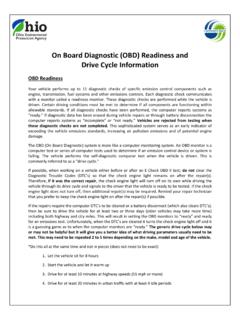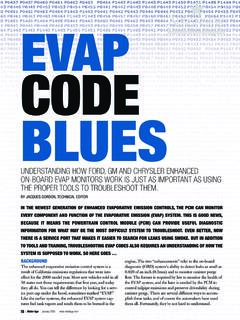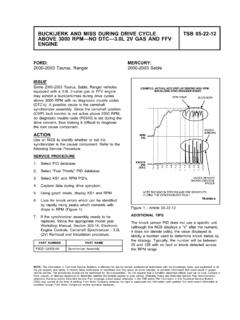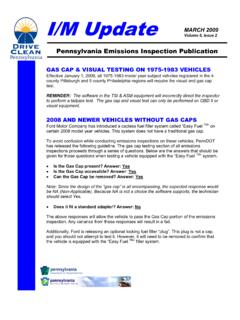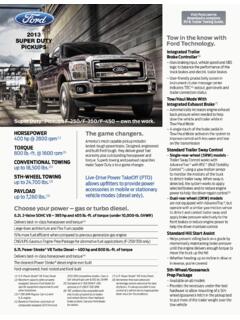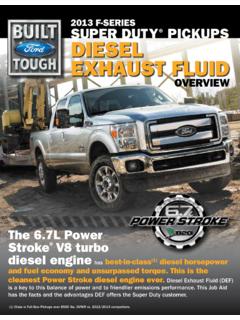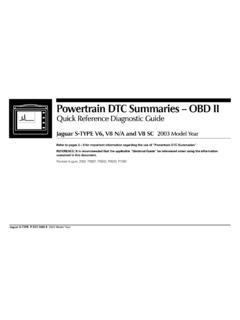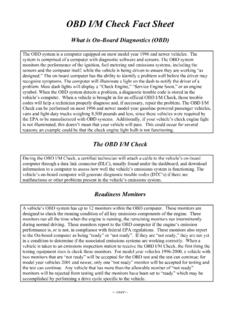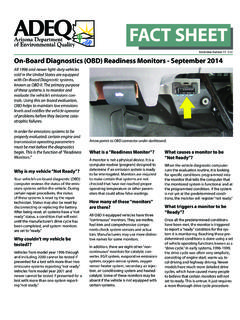Transcription of Dynamometer Testing of USPS EV Conversions - energy.gov
1 Managed by UT-Battellefor the Department of EnergyP. T. Jones (PI)Oak Ridge National LaboratoryDynamometer Testing of usps EV ConversionsThis presentation does not contain any proprietary, confidential, or otherwise restricted informationVSS0602010 DOE Hydrogen Program and Vehicle Technologies Program Annual Merit Review and Peer Evaluation MeetingMay 11, 2011 Lee SlezakVehicle Technologies Department of Energy2 Managed by UT-Battellefor the Department of EnergyOverview Timeline Project start date: Nov. 2010 Project end date: May 2011 100% complete Barriers Unique vehicle mission, drive cycle Standardized test development Charging infrastructure Vehicle readiness Budget New project, FY10 funding FY10 funding: $ 200 k usps Provided Vehicles FY11 (current) funding: $0k project completed Partners Oak Ridge National Laboratory Idaho National Laboratory VSS033 United States Postal Service Ecotality NA3 Managed by UT-Battellefor the Department of EnergyObjectives Perform benchmark Dynamometer Testing on usps Electric Vehicle Conversions Quantify vehicle performance using both standardized test methods and project specific test methods.
2 Characterize vehicle performance in various driving modes4 Managed by UT-Battellefor the Department of EnergyVehicle Technology Program (VTP) - Relevance VTP Multi-Year Program Plan (2 key goals from VSST Subprogram) Demonstrate market readiness of grid-connected vehicle technologies by 2015. Support the laboratory and field evaluations of large-scale demonstration fleets of advanced commercial and passenger PHEVs and EVs. Barriers Public acceptance of electric drive as central vehicle choice Government to show leadership in usage of advanced vehicle technologies Battery cost and durability Though not directly evaluated in this program, right sizing components for mission design is critical consumer behavior and understanding 5 Managed by UT-Battellefor the Department of EnergyBackground usps Fleet - RelevanceLargest non-military fleet in the world* Range of Road vehicles T3 to Windstar to Class 8 Various Technology ApplicationsAir, Rail, and Marine & 44K Alternative fuel vehiclesBio- ,LNG, CNG.
3 Electric Vehicles Huge fleet operation costs/logisticsFuel used in 2010 650 Million gallons (street, highway and air)Cost of fuel impact 1 cent/gallon increase ~$ record prices ($ ) increase equates to $31M/month**Driven distance in 2010 4+ million miles per day* Electrification of Delivery Vehicles , Postal Service, Office of Inspector General, DA-WP-09-001, August, 2009. ** Steve Masse, VP usps Finance and Planning6 Managed by UT-Battellefor the Department of EnergyUSPS Electric Vehicle History* - Relevance Previous electric vehicles 2000-2003 ford Based EV500 EV Ranger based delivery vehiclesPredominantly in California, few in Washington , and NYReplaced with Gasoline Windstarswhen ford ended their EV programCleveland, Ohio, 189922 miles route 2 hr previously powered by horse taking 6 , California, thru 1982, Cupertino converted its entire 30 vehicle fleet.
4 * by UT-Battellefor the Department of EnergyProject Focus Area -RelevanceGrumman Aluminum bodyModified Chevrolet S-10 Chassis4 cylinder and 3spd AutoRear Wheel Drive142,000 Vehicles in serviceEPA Rated at 18 MPG Real mail delivery MPG** Electrification of Delivery Vehicles , Postal Service, Office of Inspector General, DA-WP-09-001, August, 2009. Long Life Vehicle (LLV)~ 10 MPG8 Managed by UT-Battellefor the Department of EnergyOpportunities to Meet VTP Goals -Relevance* Modified chart; original chart source: Real Mail Delivery Driving9 Managed by UT-Battellefor the Department of EnergyUnited States Postal Service ( usps ) Key Vehicle Requirements - Project Management - First article acceptance, infrastructure, field test and evaluation Vehicle Conversions meet numerous FMVSS and SAE EV safety specifications usps Basic requirements for EV LLV 0 15 mph within 5 seconds 0 55 mph within 35 seconds 110V recharge @ 15 amps 25 mile range over described route Maintain 1000 lbcargo carrying capacity Heater/Power steering no Manual shifting Maintain 40 foot turning radius5 Awards Convert a vehicle (provided by usps ), 1 year evaluationIdaho National Laboratory (INL)
5 PI -Jim Francfort and Richard Barney Carlson Field data collection and analysis (VSS033)Ecotality Vehicle Prep, baseline test and vehicle characterizationUSPS EV conversion Project - Relevance10 Managed by UT-Battellefor the Department of EnergyApproach Test Procedure development and selection (INL & usps ) SAE original J1634: Electric Vehicle Energy Consumption and Range Test Procedure Develop usps worst-case Delivery cycle based on bin data Vehicle track characterization (INL & Ecotality NA) Perform vehicle coast down Testing Establish vehicles meet minimum performance criteria and instrument: Performance Energy consumption, charging requirements Emissions Conduct Dynamometer Testing (ORNL) Utilize AC motoring chassis dyno and instrumentation to capture energy usage data Compare and Validate (INL and ORNL) Field usage data with dyno results11 Managed by UT-Battellefor the Department of EnergyTest Procedure - Strategy J1634 type Testing based on the Federal Emission Test Procedure using the Urban Dynamometer Driving Schedule (UDDS)
6 And the Highway Fuel Economy Driving Schedule (HFEDS Complete usable ESS capacity used in transient drive cycles C/3 Range Testing Based on vehicle battery rated capacity Steady state cruise at speed determined Complete usable ESS capacity used in three one hour drives usps Simulated Delivery cycle (worst case scenario) next slides12 Managed by UT-Battellefor the Department of EnergyTest Procedure Development - ApproachUSPS Delivery cycle (worst case)13 Managed by UT-Battellefor the Department of EnergyTest Procedure Development - Approach usps Delivery cycle (worst case)Speed (mph)Time (sec)14 Managed by UT-Battellefor the Department of EnergyMilestones - Progress Milestone #1, February 28, 2011: Benchmark Testing on all 5 EV conversion vehicles completed Final vehicle leaves for usps EngineeringAOP Project Objective: The purpose of this task is benchmark up to five (5) United States Post Office delivery vehicles that have been converted to operate as battery electric vehicles (BEV).)
7 This task was funded late in FY2010, and benchmarking Dynamometer work will be carried out in FY2011. 15 Managed by UT-Battellefor the Department of EnergyVehicle Architecture Summary16 Managed by UT-Battellefor the Department of EnergyVehicle Test Results Summary** Testing complete and data supplied to Program management, under review with Supplier* Duration of charge due to ESS and usps requirements17 Managed by UT-Battellefor the Department of EnergyVehicle Graphical Comparison - Progress18 Managed by UT-Battellefor the Department of EnergyVehicle Testing Summary - Progress19 Managed by UT-Battellefor the Department of EnergyVehicle Summary - ProgressA stable fuel/energy price, which for the tested EV architectures, yields significant fuel savings over the current LLVs.
8 Though conversion cost are high20 Managed by UT-Battellefor the Department of EnergyAccomplishments Vehicle and Data Sharing Transfer of vehicles to ORNL for Testing in route to usps field deployment Evaluated using new project specific drive cycle (worst case scenario) Quantified vehicle initial vehicle performance using standardized tests Summarized vehicle information for field data comparison and future test procedure modifications21 Managed by UT-Battellefor the Department of EnergyCollaboration and Coordination with Other InstitutionsUnited States Postal Service ( usps ) Vehicle Engineering and Evaluation Han Dinh, Joseph McGrath and J. Smith Overall Program Management Field deployment Statement of Work Key Vehicle Requirements - Performance, safety, charging First article Testing , Infrastructure, Overall test and EvaluationIdaho National Laboratory (INL) Project Management PI -Jim Francfort and Richard Barney Carlson Vehicle preparation and project leads Field data collection and analysis (VSS033)
9 Ecotality -baseline test and vehicle characterization22 Managed by UT-Battellefor the Department of EnergySummary Benchmark Dynamometer Testing was performed on five usps Electric Vehicle Conversions at Oak Ridge National Laboratory ORNL used standardized test methods and specific program test methods to quantify vehicle performance and report to INL (Lead Project Lab). Analysis was performed on vehicle test results to identify areas of interest in various driving modes23 Managed by UT-Battellefor the Department of EnergyFuture Work Obtain in-use delivery drive cycle information and access test drive cycle impacts Establish baseline vehicle model to identify architecture sensitivity to drive cycle Use vehicle modeling to identify maximum regeneration possible from vehicles24 Managed by UT-Battellefor the Department of EnergyAcknowledgements and ContactsDOE Vehicle Technologies Program: Lee Slezak, Vehicle Systems ManagerOak Ridge National Laboratory (ORNL) David E.
10 Smith, Advanced Vehicle Systems Program Investigators: Jones Paul Chambon Investigators: Richard Barney Carlson Vehicle Engineering and Evaluation Han Dinh and Joseph McGrath










